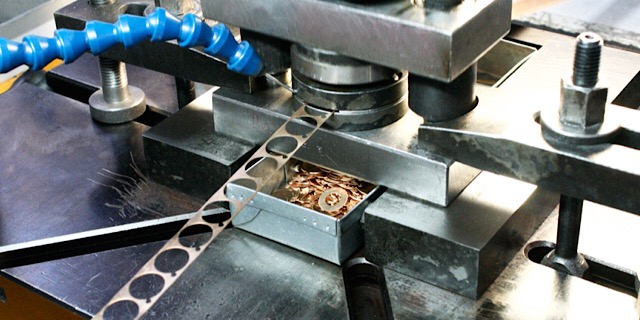Greatest Guide to Metal Stamping Techniques and Applications
Greatest Guide to Metal Stamping Techniques and Applications
Blog Article
Steel Marking Advancements: Elevating Manufacturing Processes for Superior Results
In the world of producing processes, steel marking has long been a cornerstone technique for producing a range of precision elements. With the unrelenting march of technical advancement, the landscape of steel marking is undertaking a considerable makeover.
Advancement of Steel Marking Strategies

In addition, innovations in material science have actually caused the development of high-strength alloys that can now be perfectly stamped right into elaborate shapes, providing to a more comprehensive range of industrial applications. The assimilation of robotics and fabricated intelligence has actually better maximized the stamping process by improving speed and precision while minimizing the threat of human mistake.

Influence of Advanced Products
Have innovative materials changed metal stamping processes substantially in the production market? By utilizing products such as high-strength alloys, advanced composites, and cutting-edge finishes, metal marking procedures can currently generate elements that are lighter, stronger, and much more resilient than ever in the past.
These innovative products offer remarkable mechanical buildings, deterioration resistance, and thermal stability, allowing manufacturers to fulfill the demands of modern-day markets such as aerospace, automotive, and electronics. In addition, making use of innovative products in steel stamping has actually facilitated the manufacturing of complex geometries and intricate designs that were previously unattainable through typical approaches.
Moreover, the execution of advanced materials has actually led to minimized product waste, reduced manufacturing expenses, and shorter preparations, making metal marking procedures much more sustainable and cost-effective. As technology continues to development, the impact of innovative materials on metal stamping processes is anticipated to drive further development and enhance the competition of suppliers in the international market.
Automation in Metal Stamping
The advancement of metal stamping procedures driven by the combination of innovative products has actually set the stage for considerable developments in automation within the production market. Automation in steel marking has revolutionized manufacturing procedures, improving efficiency, accuracy, and total outcome quality. Through the use of robotics, sensors, and computer-controlled systems, jobs that were as soon as hand-operated and time-consuming can currently be executed with unrivaled rate and accuracy.
Automation in metal marking not only increases production rates yet likewise makes sure consistency in the manufacturing process. By minimizing human intervention, the danger of mistakes is substantially lowered, leading to greater levels of product harmony and dependability. Furthermore, automation makes it possible for makers to undertake complex marking jobs that would be tough or impractical to accomplish by hand.
Furthermore, automation in steel marking adds to a safer working setting by decreasing the requirement for employees to take part in repeated or unsafe jobs - Metal Stamping. This change in the direction of automation not only enhances performance however also leads the way for the future of manufacturing, where innovation plays a main function in driving functional quality
High Quality Control and Examination Systems
With a concentrate on precision and dependability, quality assurance and inspection systems play a critical role in making sure item quality in steel stamping procedures. These systems are developed to keep an eye on every phase of manufacturing, from product examination to the final item, to guarantee that all components meet the required requirements. By helpful hints carrying out sophisticated innovations such as optical inspection systems, coordinate determining machines (CMM), and automated gauging tools, makers can spot even the smallest deviations in dimensions, surface area top quality, and total honesty of stamped components.

Sustainability Practices in Steel Stamping
Building upon the foundation of precision and here are the findings reliability developed with quality assurance and inspection systems, the assimilation of lasting methods in metal stamping procedures is increasingly ending up being a centerpiece for manufacturers looking for to decrease ecological effect and enhance resource usage. Sustainability practices in steel stamping encompass an array of efforts targeted at reducing waste generation, power usage, and greenhouse gas emissions throughout the production procedure.
One key facet of sustainability in metal stamping is the fostering of environmentally friendly materials and technologies that promote recyclability and waste reduction. By utilizing recycled materials and implementing energy-efficient equipment, producers can decrease their carbon impact and contribute to an extra sustainable production cycle. Furthermore, optimizing manufacturing processes to lessen material waste and power usage not only profits the atmosphere but likewise leads to cost financial savings for services over time.
Moreover, the implementation of sustainable methods in steel stamping can improve brand name online reputation and appeal to environmentally aware consumers. As sustainability proceeds to gain value in the production market, integrating environment-friendly initiatives right into metal marking processes is vital for long-term success and competitiveness in the market.
Verdict
Finally, metal marking techniques have actually considerably evolved gradually, including sophisticated materials and automation to enhance producing processes. Quality control and evaluation systems play a crucial function in ensuring remarkable outcomes, while sustainability practices are significantly being implemented to decrease environmental influence. These innovations in metal marking have revolutionized the market, bring about much more effective and lasting manufacturing approaches for view publisher site numerous sectors.
Steel marking, when a handbook and labor-intensive procedure, has actually transformed into an extremely automated and advanced technique of shaping metal sheets right into numerous forms and designs.Have advanced products changed metal stamping processes substantially in the manufacturing industry? By utilizing materials such as high-strength alloys, advanced composites, and ingenious layers, steel marking processes can now create components that are lighter, more powerful, and extra sturdy than ever previously.
The development of metal stamping procedures driven by the assimilation of innovative products has set the phase for substantial innovations in automation within the manufacturing market.In conclusion, steel marking strategies have considerably developed over time, integrating sophisticated materials and automation to improve making processes.
Report this page